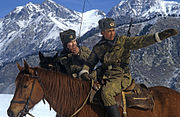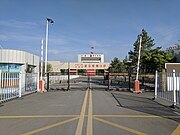Khorgos
Khorgos
Korgas, Khorgas, Horgos | |
|---|---|
Downtown Khorgos, with the Dzungarian Alatau visible in the background Khorgos Gate on the China–Kazakhstan border | |
| Coordinates: 44°12′45″N 80°24′35″E / 44.21250°N 80.40972°E | |
| Country | China |
| Autonomous region | Xinjiang |
| Autonomous prefecture | Ili |
| Municipal seat | Qarasu Subdistrict |
| Area | |
• Total | 1,675 km2 (647 sq mi) |
| Population (2020)[1] | |
• Total | 71,466 |
| • Density | 43/km2 (110/sq mi) |
| Time zone | UTC+8 (China Standard Time[a]) |
| Website | www |
| Khorgos | |||||||
|---|---|---|---|---|---|---|---|
| Chinese name | |||||||
| Simplified Chinese | 霍尔果斯市 | ||||||
| Traditional Chinese | 霍爾果斯市 | ||||||
| |||||||
| Uyghur name | |||||||
| Uyghur | قورغاس شەھىرى | ||||||
| |||||||
| Russian name | |||||||
| Russian | Хоргос | ||||||
| Romanization | Khorgos | ||||||
| Kazakh name | |||||||
| Kazakh | قورعاس قالاسى Қорғас қаласы Qorğas qalası | ||||||
Khorgos (from Russian: Хоргос), officially known as Korgas[2] (from Kazakh: قورعاس), is a county-level city in Ili Kazakh Autonomous Prefecture, Xinjiang, China. It straddles the country's border with Kazakhstan;[3] on the Kazakh side of the border is a city also named Horgos in Russian and Korgas in Kazakh.
Khorgos area is a hub of the New Eurasian Land Bridge, 200 km from the Alataw Pass, the historically important Dzungarian Gate, with a cross-border visa-free special economic zone for trade and shopping (ICBC), a dry port for transporting goods and two new cities, one on either side of the border.[4][5]: 24
History
[edit]In 1851, the Russian Empire signed an agreement with Qing China to have Khorgos and Tacheng opened as port of entries along the Qing-Russian border.[6]
In 1977, the 61st Regiment Farm fire in Khorgos killed 694 and injured 161.[7][8] It is one of the worst human-made disasters in China by death toll.
Transportation
[edit]The Jinghe–Yining–Khorgos railway was completed in late 2009 and as of 2012 provides train service from Ürümqi and Yining to Khorgos.[9]
Passenger trains from Ürümqi started on July 1, 2010; however, they initially only ran to Yining and not all the way to Khorgos.[10][11] In December 2013, one of the daily Ürümqi-Yining passenger trains was extended to Khorgos. The travel time from Khorgos to Yining then was just over an hour.[12]
In December 2011, a 293-kilometre (182 mi) railway from the Khorgos border crossing to Zhetygen terminal (near Almaty) was completed; on December 2, 2012, the tracks from the Chinese and Kazakhstan sides of the borders were connected.[13] For some months, the railway on the Kazakh side was still operating in a test mode.[14] The railway border crossing (port of entry) at Khorgos became operational in the late 2012;[15]) the first regular trains from the two countries crossed the border on December 22, 2012.[13] Thus, Khorgos, an international dry port, connects land-locked Kazakhstan to the sea port of Lianyungang in China.[16]
The railway border crossing is expected to handle up to 15 million tons of freight per year initially, the volume rising to 30 million tons per year in the long run,[13] opening up the second Europe-China rail link via Kazakhstan.[17]
Khorgos is a major break of gauge interchange. 41-ton gantry cranes are used to move shipping containers between standard gauge Chinese trains and Russian gauge Kazakh trains,[18] connecting to Altynkol railway station on a spur line of Kazakhstan Temir Zholy.
In June 2017, the Ürümqi Railway Bureau of the China Railway started daily passenger service from Ürümqi to Astana via Khorgos.[19]
Economy
[edit]As of at least 2024, Khorgos is the second-largest dry port in the world.[20]: 57
In 2017, Boshihao Electronics, a robot manufacturing company, moved production from Shenzhen to Khorgos.[21]
Climate
[edit]| Climate data for Korgas, elevation 722 m (2,369 ft), (1991–2020 normals) | |||||||||||||
|---|---|---|---|---|---|---|---|---|---|---|---|---|---|
| Month | Jan | Feb | Mar | Apr | May | Jun | Jul | Aug | Sep | Oct | Nov | Dec | Year |
| Mean daily maximum °C (°F) | −0.9 (30.4) |
2.0 (35.6) |
11.1 (52.0) |
20.3 (68.5) |
25.4 (77.7) |
29.4 (84.9) |
31.3 (88.3) |
30.6 (87.1) |
25.9 (78.6) |
18.0 (64.4) |
8.5 (47.3) |
1.3 (34.3) |
16.9 (62.4) |
| Daily mean °C (°F) | −5.8 (21.6) |
−2.8 (27.0) |
5.6 (42.1) |
13.6 (56.5) |
18.6 (65.5) |
22.7 (72.9) |
24.6 (76.3) |
23.8 (74.8) |
19.0 (66.2) |
11.6 (52.9) |
3.4 (38.1) |
−3.2 (26.2) |
10.9 (51.7) |
| Mean daily minimum °C (°F) | −9.5 (14.9) |
−6.5 (20.3) |
1.1 (34.0) |
8.3 (46.9) |
12.9 (55.2) |
17.1 (62.8) |
19.0 (66.2) |
17.9 (64.2) |
13.2 (55.8) |
6.6 (43.9) |
−0.2 (31.6) |
−6.7 (19.9) |
6.1 (43.0) |
| Average precipitation mm (inches) | 19.4 (0.76) |
19.2 (0.76) |
17.2 (0.68) |
28.3 (1.11) |
24.8 (0.98) |
33.7 (1.33) |
26.5 (1.04) |
17.3 (0.68) |
11.9 (0.47) |
20.7 (0.81) |
26.9 (1.06) |
20.9 (0.82) |
266.8 (10.5) |
| Average precipitation days (≥ 0.1 mm) | 8.6 | 8.1 | 6.5 | 7.0 | 7.8 | 8.6 | 8.2 | 5.8 | 4.2 | 5.2 | 7.2 | 8.8 | 86 |
| Average snowy days | 9.9 | 9.5 | 3.9 | 1.0 | 0 | 0 | 0 | 0 | 0 | 0.8 | 5.1 | 10.1 | 40.3 |
| Average relative humidity (%) | 69 | 69 | 59 | 49 | 46 | 47 | 46 | 43 | 43 | 52 | 65 | 71 | 55 |
| Mean monthly sunshine hours | 160.8 | 175.6 | 234.7 | 266.9 | 319.8 | 325.1 | 344.1 | 329.5 | 285.7 | 240.3 | 161.1 | 144.4 | 2,988 |
| Percent possible sunshine | 55 | 58 | 62 | 65 | 69 | 70 | 74 | 78 | 78 | 72 | 57 | 53 | 66 |
| Source: China Meteorological Administration[22][23] | |||||||||||||
Administrative divisions
[edit]Khorgos is divided into 4 subdistricts, 1 ethnic township, and 2 township-equivalent regions.
| Name | Simplified Chinese | Hanyu Pinyin | Uyghur (UEY) | Uyghur Latin (ULY) | Kazakh (Arabic script) | Kazakh (Cyrillic script) | Administrative division code | Notes |
|---|---|---|---|---|---|---|---|---|
| Subdistricts | ||||||||
| Qarasu Subdistrict | 卡拉苏街道 | Kǎlāsū Jiēdào | قاراسۇ كوچا باشقارمىسى | qarasu kocha bashqarmisi | قاراسۋ ءمالى باسقارماسى | [Қарасу мәлі басқармасы] Error: {{Transliteration}}: transliteration text not Latin script (pos 1) (help) | 654004001 | |
| Ya-Ou East Road Subdistrict | 亚欧东路街道 | Yà'ōudōnglù Jiēdào | ياۋروئاسىيا شەرقىي يولى كوچا باشقارمىسى | Yawro'asiya sherqiy yoli kocha bashqarmisi | ەۆرو-ازيا شىعىس جولى ءمالى باسقارماسى | [Еуразия шығыс жолы мәлі басқармасы] Error: {{Transliteration}}: transliteration text not Latin script (pos 1) (help) | 654004002 | |
| Ya-Ou West Road Subdistrict | 亚欧西路街道 | Yà'ōuxīlù Jiēdào | ياۋروئاسىيا غەربىي يولى كوچا باشقارمىسى | Yawro'asiya gherbiy yoli kocha bashqarmisi | ەۆرو-ازيا باتىس جولى ءمالى باسقارماسى | [Еуразия батыс жолы мәлі басқармасы] Error: {{Transliteration}}: transliteration text not Latin script (pos 1) (help) | 654004003 | |
| Industrial Park Subdistrict | 工业园区街道 | Gōngyèyuánqū Jiēdào | سانائەت رايونى كوچا باشقارمىسى | sana'et rayoni kocha bashqarmisi | ونەركاسىپتىك اۋدان ءمالى باسقارماسى | [Өнеркәсіптік аудан мәлі басқармасы] Error: {{Transliteration}}: transliteration text not Latin script (pos 1) (help) | 654004004 | |
| Ethnic township | ||||||||
| Ichëgashen Township (Ichëgashen Sibe Ethnic Township) |
伊车嘎善乡 (伊车嘎善锡伯族乡) |
Yīchēgāshàn Xiāng (Yīchēgāshàn Xíbózú Xiāng) |
ئىچېگاشەن شىبە يېزىسى | Ichëgashen shibe yëzisi | يچىگاشان سىبە ۇلتتىق اۋىلى | [Ичігәшән Сібе Ұлттық ауылы] Error: {{Transliteration}}: transliteration text not Latin script (pos 1) (help) | 654004200 | (Xibe) ᡞᠴᡝ ᡤᠠᡧᠠᠨ ᠰᡞᠪᡝ ᡤᡡᠰᠠ ice gašan sibe gūsa |
Others:
- 61st Regiment Farm (六十一团)
- 62nd Regiment Farm (六十二团)
See also
[edit]- Transport in China
- Transport in Kazakhstan
- Railway stations in China
- Railway stations in Kazakhstan
- Nurkent
Gallery
[edit]-
The 1758 Victory of Khorgos, a 1774 engraving by Jacques-Philippe Le Bas (1707-1783), after Jean-Denis Attiret (1702-1768). Musée Guimet, Paris.[24]
-
Soviet border guards near Korgas (1984)
-
Korgas port gate
Notes
[edit]- ^ Locals in Xinjiang frequently observe UTC+6 (Xinjiang Time), two hours behind Beijing.
References
[edit]- ^ Xinjiang: Prefectures, Cities, Districts and Counties
- ^ The official spelling according to Zhōngguó dìmínglù, 中国地名录 (Beijing, SinoMaps Press 中国地图出版社 1997); ISBN 7-5031-1718-4
- ^ Reid Standish (1 October 2019). "China's Path Forward Is Getting Bumpy". theatlantic.com. 2nd paragraph of article: The Atlantic. Retrieved 17 March 2020.
Straddling the Kazakh-Chinese border, a collection of cranes, railways, and buildings rises out of a barren stretch of desert surrounded by towering mountains to form the backbone of the Khorgos Gateway
{{cite web}}: CS1 maint: location (link) - ^ "Khorgos and Zharkent travel guide". Caravanistan. Retrieved 2019-08-19.
- ^ Curtis, Simon; Klaus, Ian (2024). The Belt and Road City: Geopolitics, Urbanization, and China's Search for a New International Order. New Haven and London: Yale University Press. ISBN 9780300266900.
- ^ "霍尔果斯口岸国门". 伊犁哈萨克自治州人民政府. 2009-11-12. Archived from the original on 2021-09-12. Retrieved 2021-08-21.
- ^ 西夫 (1995). "694条生命化为灰烬——一场没有公开报道的特大火灾". 新世纪 (4). Archived from the original on 2023-01-04. Retrieved 2023-01-04.
- ^ "一九七七年 六十一团那场大火" [The great fire to the 61st Regiment in 1977]. 伊犁晚报. 2018-03-28 [2007-02-26]. p. B06. Archived from the original on 2023-01-04 – via 老知青家园.
- ^ "Xingjiang's first electrified railway rails laid". People's Daily Online. 2009-09-17. Retrieved 2012-03-13.
- ^ Zhaoqian, ed. (2010-06-22). "Tickets of train from Urumqi to Yining put on sale". Tianshannet. Archived from the original on 2012-02-29. Retrieved 2012-03-13.
{{cite news}}: CS1 maint: unfit URL (link) - ^ "Xinjiang's first electrified railway passenger train". China Central Television. 2010-07-07. Retrieved 2012-03-13.
- ^ 霍尔果斯往乌鲁木齐方向首趟客运列车正式开通 (The first Korgas-Ürümqi passenger train started regular operations), 2013-12-26
- ^ a b c 写在中国霍尔果斯至哈萨克斯坦阿腾科里铁路通车运营之际, 2012-12-23
- ^ Хоргос-Жетыген: уже летом первые поезда соединят Китай с Европой (Already this summer first trains will connect China with Europe), 2012-03-16 (in Russian)
- ^ 新疆霍尔果斯火车站获批成立 年底有望通车 Archived 2013-07-29 at the Wayback Machine, 中国新闻网, 2012-11-23
- ^ Vakulchuk, Roman and Indra Overland (2019) “China’s Belt and Road Initiative through the Lens of Central Asia”, in Fanny M. Cheung and Ying-yi Hong (eds) Regional Connection under the Belt and Road Initiative. The Prospects for Economic and Financial Cooperation. London: Routledge, pp. 119.
- ^ Revival of the Silk Road
- ^ Shepard, Wade (2017-02-20), "Khorgos: The New Silk Road's Central Station Comes To Life", Forbes
- ^ 今夏可坐火车去哈萨克斯坦游玩 (This summer, one can visit Kazakhstan by train)
- ^ Curtis, Simon; Klaus, Ian (2024). The Belt and Road City: Geopolitics, Urbanization, and China's Search for a New International Order. New Haven and London: Yale University Press. ISBN 9780300266900.
- ^ Shepard, Wade. "Horgos: The First New City Of The New Silk Road Emerges As A Robot Manufacturing Hub".
{{cite journal}}: Cite journal requires|journal=(help) - ^ 中国气象数据网 – WeatherBk Data (in Simplified Chinese). China Meteorological Administration. Retrieved 10 October 2023.
- ^ 中国气象数据网 (in Simplified Chinese). China Meteorological Administration. Retrieved 10 October 2023.
- ^ Victory of Khorgos






![The 1758 Victory of Khorgos, a 1774 engraving by Jacques-Philippe Le Bas (1707-1783), after Jean-Denis Attiret (1702-1768). Musée Guimet, Paris.[24]](http://upload.wikimedia.org/wikipedia/commons/thumb/8/84/Jean_Denis_Attiret_-_Victory_at_Heluo_Heshi-_from_Battle_Scenes_of_the_Quelling_of_Rebellions_in_-_1998.103.4_-_Cleveland_Museum_of_Art.jpg/180px-Jean_Denis_Attiret_-_Victory_at_Heluo_Heshi-_from_Battle_Scenes_of_the_Quelling_of_Rebellions_in_-_1998.103.4_-_Cleveland_Museum_of_Art.jpg)

